Introduction
Singapore and Hong Kong are two similar city states that have in practice a number of multinational companies interested in the real estate business with investments in the real estate industry being one of the greatest revenue earners to their economies. In terms of macro-economic factors, Singapore and Hong Kong have the same size of land and population density and are located in the South Eastern Asia.
Studies show that the GDP of Hong Kong is 92% and is service based, with 8% of the GDP based on industrial investments. On the other hand, Singapore has 34% of its GDP being industrial based and 66% of its GDP being service based.
From the perspective of real estate investments in both Hong Kong and Singapore, investments are facilitated by the private and public sectors, with investments in the real estate market registering quantum leaps despite the recent global economic meltdowns.
In Hong Kong, part of the investment in the real estate are done by people from the mainland China interested in moving their investments from the mainland China to Hong Kong.
Land in both Singapore and Hong Kong, which forms the basis for making investments in the real estate business is held under the public land ownership by the city states. In both cases, the allocation of land is done through a lease that lasts between 5 and 99 years. In both cases, extensive land ownership is crucial in the development of urban property and in the way the property market functions in the stock market.
In this case, the most important element is public land ownership. The allocation of land varies significantly between the two states, where Singapore uses the market allocation mechanism and Hong Kong using the lease method. However, land lease for each of the city states have similarities in that the land does not permanently belong to the real estate companies.
Singapore
Singapore is a city state with a surface area of 710 square km, a population density of 6814 people per square kilometer, and a total population of 48.4 million people. By 2008, the city state had a gross domestic product of $ 257 billion with a per capita GDP of $ 53192.
Given the size of the population, the GDP, and the size of the land, one is justified to argue that land and buildings are the most significant sources of the state’s wealth and economy. Land, which is a scarce commodity in Singapore, is publicly owned.
However, the scarcity of land in Singapore has not negated the growth of the real estate industry. Rather, many multinational companies operating in the international real estate market have their origin in Singapore.
Despite the global economic meltdown, studies show that Singapore has from 2011 shown a rebound in real estate investments. Prior to the global economic meltdown, the real estate industry was performing well with a lot of resilience. The demand for housing facilities such as the smaller flat type of buildings remained high despite the negative impact the meltdown had on the financial performance of the industry.
After the 2011 intervention by the government, the real estate industry has rebound with the first three months of 2012 recoding 6526 units sold. In addition, the growth in the industry was spurred by the government’s intervention that lead developers to launch new development projects, increasing the supply of projects that buyers were at liberty to select from.
A study of the launches done in 2012 of the houses into the market show a significant rise in the number of incomplete houses launched in 2012. Contrary to the past when launches could be done in phases, in 2012, the launches were done before the completions.
The total investment and sales are illustrated in the following table.
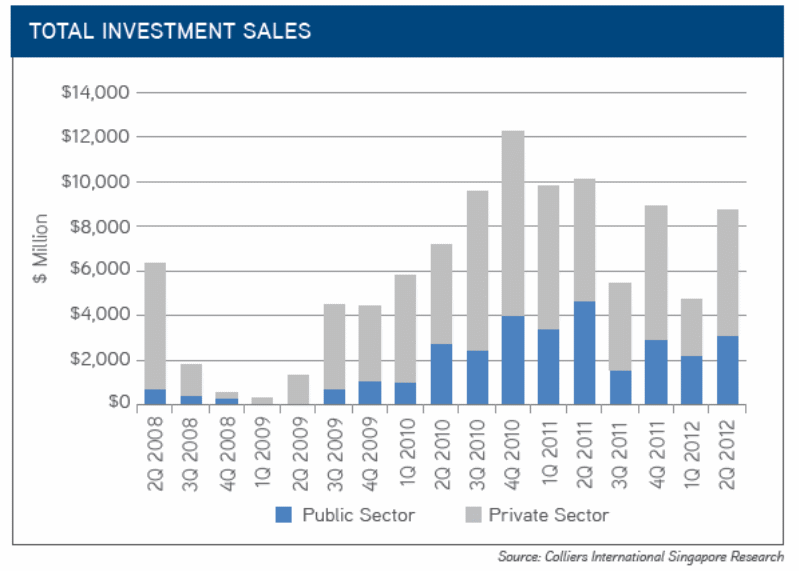
Another illustration of the trend in the real estate market in Singapore is shown in the table below.
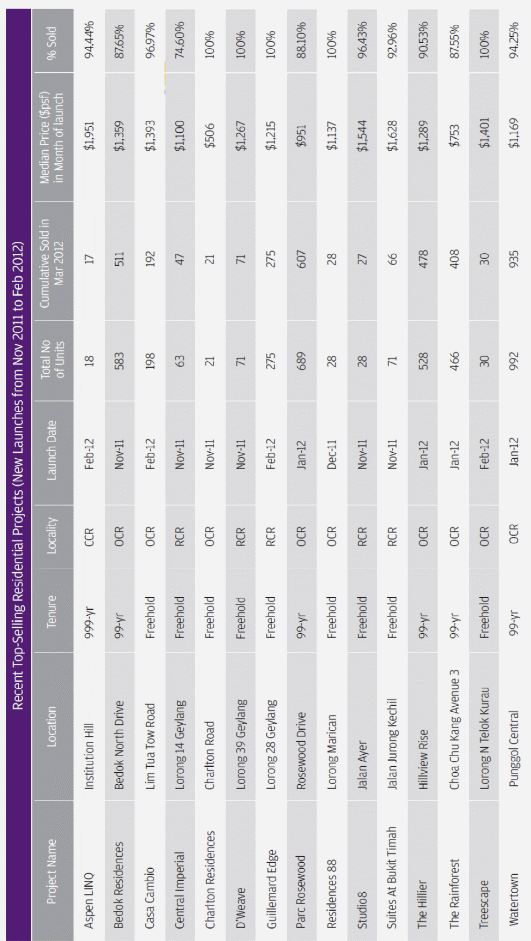
The tight connection of the economy of Singapore with the world economy caused a strong rebound in the economy because of the global demand for electronic products in 1998, but a steady decline was registered until 2004, when a rise was again noted of the residential market, with prices rebounding to the 2000 levels.
Hong Kong
Hong Kong is a city state with a number of transnational real estate companies operating and playing a significant role in the performance of the economy. Land and buildings in Hong Kong contribute significantly to the performance of the local economy with many multinational real estate companied having originated from Hong Kong. Land in Hong Kong is publicly owned.
The government is able, because of public land ownership, to give subsidies targeted at some type of land use. In the recent past, a sharp increase in real estate transactions has caused a steep rise in the value of real estate property.
A survey of the last four years has shown an increase by twice the value of the prices of homes because the government stimulated the demand based on the low interest rates which discouraged speculation.
Part of the cause in the increase in demand and price of real estate property in Hong Kong are investors from mainland China who want to move their assets to Hong Kong. In addition, the strong demand for new projects in Hong Kong has been registered with the companies agitating to increase the prices of apartments by 5% because of the robust growth.
The most recent report on real estate investments in Hong Kong shows that through the intervention of the government, property prices have drastically reduced because transactions have been so low when the government introduced a 15% tax on foreign buyers of real estate property.
Some of the companies operating in Hong Kong, which include New World Development Co., Henderson Land, and Kerry Properties Ltd. (683), have decided to invest in dilapidated buildings which were constructed over 50 years ago. Another company, New World (17), has embarked on selling a residential project at 14,000$ per square foot while the price at which the property was bought at 8000$ per square foot.
Similar to Hong Kong and Singapore, private investors own land that is not owned by the property developers. It is the case that real estate developers have experienced a significant growth in the rent charges for the properties.
Comparison and Analysis
A comparison of both Singapore and Hong Kong based on statistical data on the land size, population density, different types of the GDP are illustrated in figure 3 below.
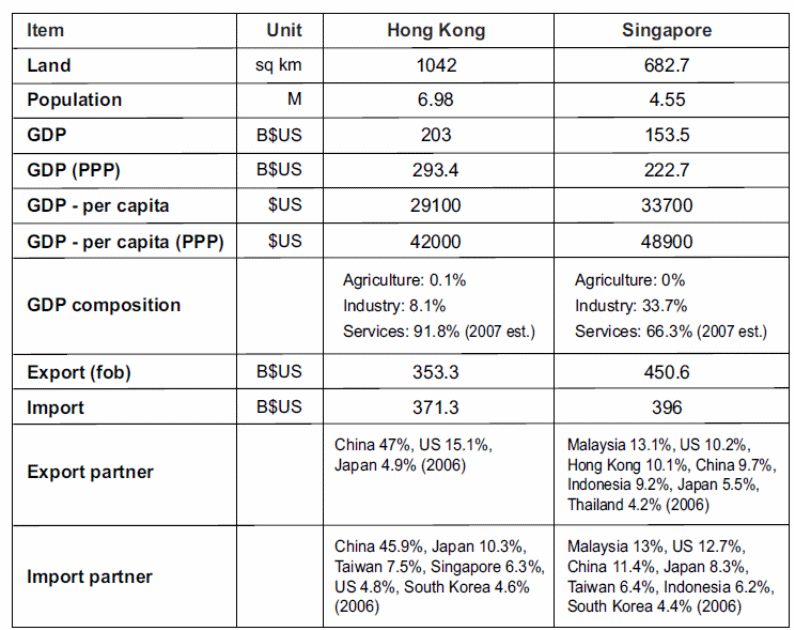
Data from the Real Capital Analytics in New York which provides information on the price per unit of the transactions of the real estate property in each of the six sectors which include retail, office, and industrial, apartments, hotels, and development sites is illustrated in figure 3 below for a 10 year period.
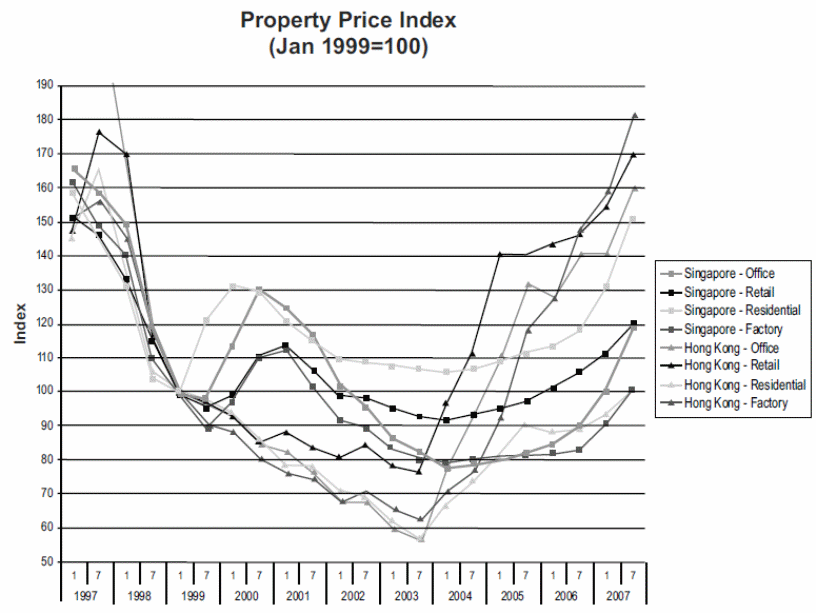
In the above analysis, Hong Kong and Singapore have a price per unit ratio lying between 1.22 and 1.47 for office, hotel, and apartment sectors. This shows a significant different in the price per unit for Singapore to be 22% to 47% lower than that of Hong Kong. Because of the usage types of land in Hong Kong, the ratio is 2.1 higher than that in Singapore mainly because of tourism.
The yield and growth for Singapore is greater than that in Hong Kong in terms of the bond rate, the cap rate, bond rate, occupancy rate, and the growth rates as illustrated in figure 4 below.
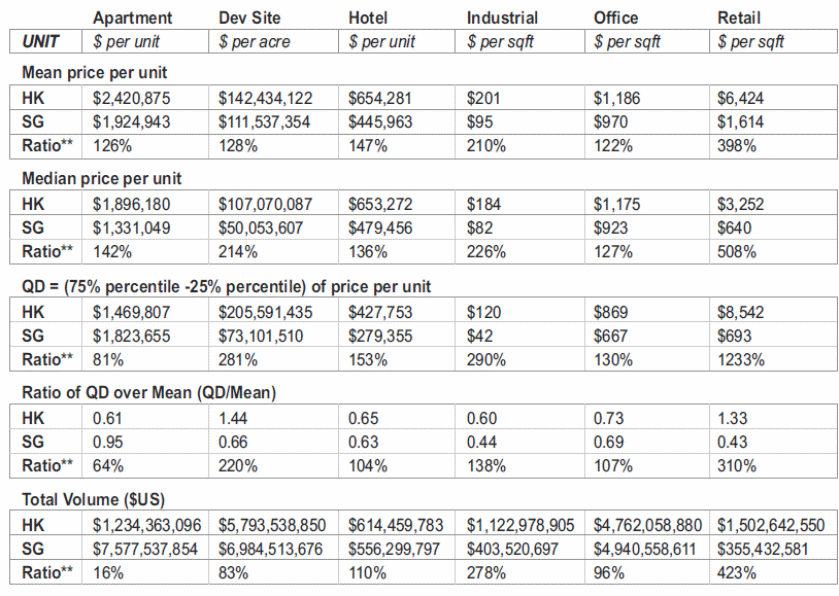
The rates per country are shown below with the respective property types detailed in the table for Singapore and Hong Kong. The figures are the occupancy, bond rate, cap rate, and the growth rate for the year 2007.
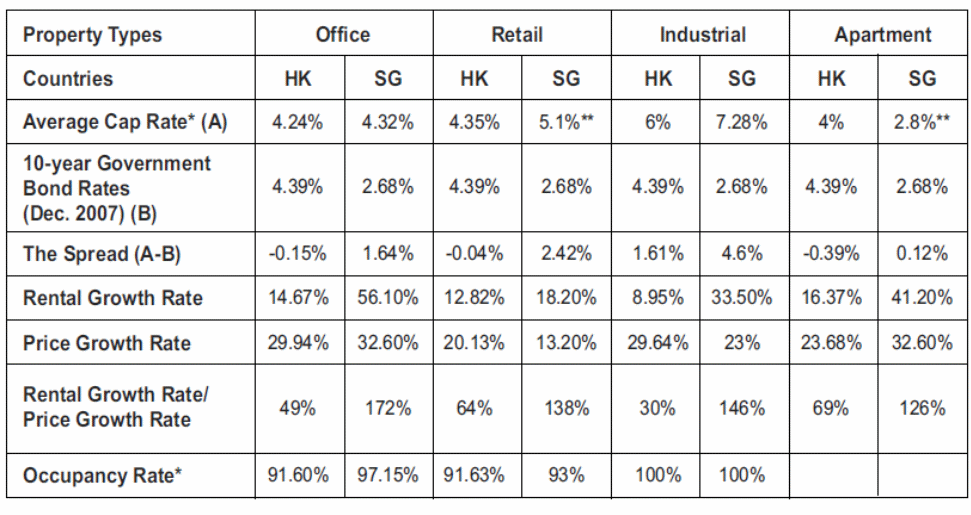
A comparative study of the real estate industry shows that land ownership is public for both Singapore and Hong Kong. Land is scarce in both city states and the real estate industry makes significant contributions to the economies of both city states. Despite the scarcity of land, many multinational companies which specialize in real estate industry have their origin in either of the two city states.
In addition, research shows that the real estate business has a strong impact on the operation of the stock markets in both states, in addition to being the point of interest for investors from different countries. In particular, Hong Kong has been the major point of attraction for investors from mainland china who want to move their assets from mainland China.
One of the factors that influence the operations of the companies investing in the real estate industry is the land ownership mechanism used by both city states. The planning practices and property laws were inherited from the British who colonized the Hong Kong and Singapore.
The tenure of land in Singapore is based on land title deeds issued by the state while inn Hong Kong, the tenure of land is held o leases, but the land is the permanent property of the state. Hong Kong and Singapore enjoy public land ownership which makes it possible for the states to subsidize the land depending on the type of land use and be able to prevent any speculations on land.
In addition, Hong Kong has many policies in place to prevent the rise in home prices by increasing the levies on transactions, and increasing the land sales to make more land available for development and reduce the cost of land. The underlying principle of controlling the rise in prices is by ensuring that all the freehold land is state property and that increases in the value of land is automatically remitted to the state.
The policy ensures that companies that speculate on price increases of undeveloped land are not able to capture and subdivide the land with the expectation of optimizing and making gains from price increases in the market.
In Hong Kong, land and buildings form a significant part of the public earnings for the state, which according to studies is about a third of its revenue. On the other hand, Singapore imposes a property tax that is higher than that in Hong Kong to generate public revenue. Research shows that developers in Singapore use the profit generated from the sales to invest in new land purchases.
The allocation of land in both Singapore and Hong Kong is based on land auctions, which is then administered on a lease hold basis. The acquisition of leases and the tenure of a lease in both city states last for 15 years, although the whole process and legacy are very complicated. Investigations show that the state property is alienated for residential, industrial, commercial, and other purposes on a lease that lasts for 99 years or less.
Both Hong Kong and Singapore allow for two types of payments to be made on the land lease. The first one is a premium sum paid at the market value of the land, and the second one is the sum paid to maintain the lease of the land.
It is possible in both city states for a company to use the land for a purpose other than the one permitted for use under the existing conditions. In such a case, the government has the obligation to modify the lease conditions at a fee for doing the modifications.
A number of facts arise from the system adapted by the city states on land auctions, public land ownership, and leaseholds. As mentioned elsewhere, public land ownership enables the government to prevent property development companies from hoarding land for speculation purposes and becoming land monopolies.
However, some companies have developed their own land banks which enable them not to rely on the Government for land auctions. Both Singapore and Hong Kong have developed land lease hold system policies that prevent large companies from getting monopoly positions, despite the fact that large companies have large land banks.
The policies provide guidelines that require small and large companies to bid for land, making fair competition for the land. Another approach that the governments use to decrease speculation is the restrictive land convents. The prevailing conditions make large companies to invest more in productive activities and facilitate the search for new foreign markets.
Facts show that land ownership in Hong Kong is allocated as a private commodity using the market mechanisms and is not based on a collective or public leases system, implying that for both nations, land ownership is private corporate property and not common property.
An investigation into the contributions of the real estate industry into the revenue of both states shows that they form a strong revenue base for the states and act as drivers of the economies. In addition, for both states, the real estate business forms an important part of the stock market. Investigations show that many people who have become rich in both states have accumulated their wealth thought the real estate business.
Conclusion
In conclusion, Hong Kong and Singapore have similarities and differences in the real estate business. Studies have shown that both city states have similar land sizes and population densities with insignificant differences between them. In addition, the states depend heavily on the revenue generated from the real estate business, which form a significant source of wealth and economic growth for the states.
The states have similar land ownership policies because the land is held on the public ownership basis. Land allocation to developers varies between the states, with Hong Kong using the market allocation mechanism and Singapore using the title deed allocation method.
Because of the of the high demand for land in both Hong Kong and Singapore, the tendency to create land banks by the multinational investment companies for speculation purposes is a problem the states have solved by introducing policies and tax remission systems to enable the state to benefit from the rise in real estate prices.
Large multinational companies have made significant investments in the real estate industry despite the economic crisis that caused a crush in the global market.
Bibliography
Chin, Tzu-Yu and Strand, John B. “Hong Kong vs. Singapore: A Comparison of Two Real Estate Markets”. Web.
Chong, Terence and Wong, Vivian, “Asset Management Industry Development in Hong Kong, Singapore and China”. Web.
Haila, Anne. Real Estate in Global Cities: Singapore and Hong Kong as Property States, Urban Studies, Vol. 37, No. 12, 2241– 2256, 2000, International Property Consultants. “Singapore Real Estate Market”. Overview” (2012). Web.
Singapore Real Estate Market, “Investment Sales Market” (2012). Web.